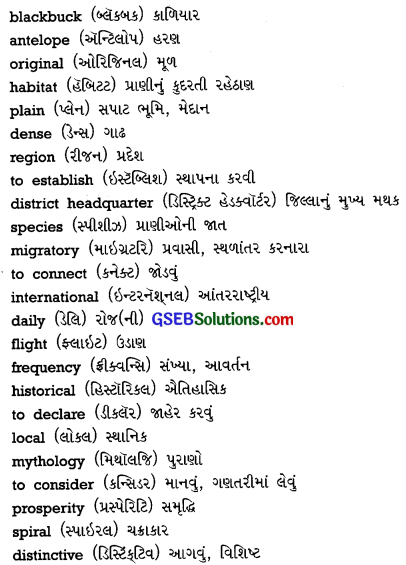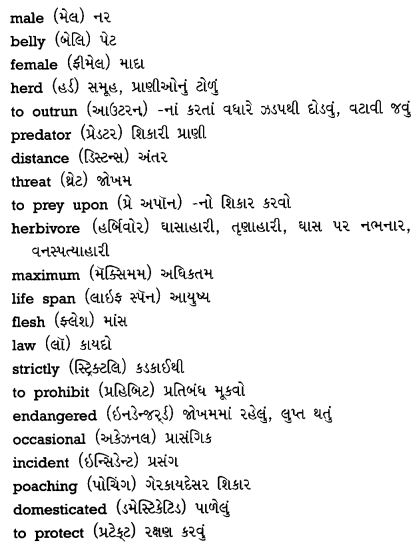Gujarat Board GSEB Solutions Class 10 English Second Language Supplementary Chapter 1 The Black Beauty of Velavadar Textbook Exercise Questions and Answers.
GSEB Class 10 English Textbook Solutions Supplementary Chapter 1 The Black Beauty of Velavadar (Second Language)
GSEB Class 10 English The Black Beauty of Velavadar Text Book Questions and Answers
Read the passage and answer the questions.
(1) Blackbuck is the fastest of all the antelopes. It is found not only in India, but also in parts of Pakistan, Nepal and some other countries. In India it is found mainly in Maharashtra, Orissa, Punjab, Rajasthan, Haryana, Gujarat, Andhra Pradesh, Tamil Nadu and Karnataka.
In Gujarat, blackbucks are seen in Saurashtra. Its original habitat is open plains and not dense jungles. There is the famous Blackbuck National Park at Velavadar in Bhal region of Saurashtra.
Blackbuck National Park at Velavadar is situated in the Bhavnagar district of Gujarat state, India. Established in 1976 in the Bhal region of Saurashtra, the park is located around 72 km from the district headquarter city of Bhavnagar.
![]()
Though the park is open throughout the year, the period between monsoon and winter normally, mid-June to March-end is a good period to see blackbucks. The best time to visit Velavadar National Park is December to March because many species of migratory birds which include three species of Harriers, Lesser Floricans, Eagles, Waders many other water birds arrive to spend winter. [Pages 1-2]
Questions :
(1) Which is the fastest of all antelopes ?
(2) Where is the blackbuck found in India ?
(3) Where is the Blackbuck National Park ?
(4) When was the Blackbuck National Park established ?
(5) Which is a good period to see the s blackbucks ?
(6) Why is December to March the best time to visit the Blackbuck National Park?
(7) Name the migratory birds mentioned in the passage.
Answers :
(1) The blackbuck is the fastest of all antelopes.
(2) In India the blackbuck is found in Maharashtra, Orissa, Punjab, Rajasthan, Haryana, Gujarat, Andhra Pradesh, Tamil Nadu and Karnataka.
(3) The Blackbuck National Park is at Velavadar in Bhavnagar district of Gujarat. The Blackbuck National Park was established in 1976.
(5) The period between monsoon and winter normally, mid-June to March-end is a good period to see blackbucks.
(6) December to March is the best time to visit the Blackbuck National Park because many species of migratory birds arrive there to spend the winter.
(7) Harriers, Lesser Floricans, Eagles, Waders.
![]()
(2) The blackbuck is also known as Krishna ]inka in Telugu language. It has been declared the state animal of Andhra Pradesh. Other local names for the species include Kala Hiran, Sasin, Iralai Maan, Krishna Mriga in Kannada and Kalveet in Marathi. According to the Indian mythology, blackbuck or Krishna Jinka is considered as the vehicle of the God Moon. According to the Garuda Purana, Krishna Jinka brings prosperity in the areas where they live. [Page 2]
Questions :
(1) What is the blackbuck called in Telugu ?
(2) Write any three local names of the blackbuck.
(3) Which state has declared the blackbuck as its state animal ?
(4) What does the Indian mythology say about the blackbuck ?
(5) What does the Garuda Purana say about the blackbuck ?
(6) What is the blackbuck called in Marathi ?
(7) What is the blackbuck called in Kannada ?
Answers:
(1) The blackbuck is called Krishna Jinka in Telugu.
(2) Kala Hiran, Iralai Maan, Sasin
(3) Andhra Pradesh has declared the blackbuck as its state animal.
(4) According to the Indian mythology, the blackbuck is the vehicle of God Moon.
(5) According to the Garuda Purana, Krishna Jinka brings prosperity in the areas where they live.
(6) The blackbuck is called Kalveet in Marathi.
(7) The blackbuck is called Krishna Mriga in Kannada.
(3) The blackbuck is famous for its spiral horns. The distinctive horns of the blackbuck are ringed with 1 to 4 spiral turns. They can be as long as 28 inches. In the male, the upper body is black and the belly and eye rings are white. The light-brown female is usually hornless. Blackbucks usually roam on the plains in herds of 15 to 20 animals with one male leader.
On the open plain, the blackbuck is one of the fastest animals and can outrun most predators over long distances. It can run 80 mph when necessary. Cheetah is said to be a threat for the blackbuck. Other wild animals such as wolves and wild dogs also prey upon the blackbucks. [Pages 2-3]
Questions :
(1) What is the blackbuck famous for ?
(2) What is distinctive about the blackbuck’s – horns ?
(3) Describe the male blackbuck.
(4) Describe the female blackbuck.
(5) Blackbucks usually roam
(6) Why is the blackbuck one of the fastest animals on the open plain?
(7) Which animal is a threat to the blackbuck ?
(8) Which wild animals prey upon the blackbuck ?
Answers :
(1) The blackbuck is famous for its spiral horns.
(2) The blackbuck’s horns are ringed with 1 to 4 spiral turns.
(3) The male blackbuck has a black upper body and the belly and eye rings are white.
(4) The female blackbuck is light-brown in colour and is usually hornless.
(5) Blackbucks usually roam on the plains in herds of 15 to 20 animals with one male leader.
(6) The blackbuck is one of the fastest animals on the open plain because it can outrun most predators over long distances and its maximum speed can 80 mph.
(7) The cheetah is a threat to the blackbuck.
(8) Wild animals like wolves and wild dogs prey upon the blackbucks.
![]()
(4) The blackbuck is a herbivore. It lives on grass, plants, flowers and fruits. The maximum life span recorded is about 16 years. The blackbuck is hunted for its flesh and its skin. Although the Indian law strictly prohibits the hunting of these endangered animals, there ’o are still occasional incidents of poaching.
The natural habitat of the blackbuck is taken away by human beings for domesticated cattle or building houses. Like most wild animals, the blackbuck is in principle protected in India by the Wildlife Protection Act of 1972. [Page 3]
Questions:
(1) Why is the blackbuck called a herbivore ?
(2) How long does the blackbuck live ?
(3) Which act protects the blackbuck ?
(4) Why is the blackbuck hunted ?
(5) The Indian law strictly prohibits
(6) For what have we taken away the natural habitat of the blackbuck?
Answers :
(1) The blackbuck is called a herbivore because it lives on grass, plants, flowers and fruits.
(2) The blackbuck lives for about 16 years.
(3) The Wildlife Protection Act of 1972 protects the blackbuck.
(4) The blackbuck is hunted for its flesh and skin.
(5) The Indian law strictly prohibits the hunting of the blackbucks.
(6) We have taken away the natural habitat of the blackbuck for domesticated cattle or building houses.
Select the word having the nearest meaning.
Question 1.
habitat
A. habit
B. area
C. home
D. zoo
Answer:
C. home
Question 2.
dense
A. thick
B. deep
C. thin
D. fat
Answer:
A. thick
Question 3.
region
A. location
B. place
C. local
D. area
Answer:
D. area
![]()
Question 4.
connect
A. track
B. ring
C. join
D. call
Answer:
C. join
Question 5.
daily
A.every day
B. regularly
C. always
D. often
Answer:
A.every day
Question 6.
frequency
A. frequently
B. occupancy
C. regularity
D. irregularity
Answer:
C. regularity
Question 7.
declare
A. present
B. announce
C. secret
D. tell
Answer:
B. announce
Question 8.
Consider
A. think
B. refuse
C. accept
D. read
Answer:
A. think
![]()
Question 9.
threat
A. signal
B. warning
C. shouting
D. Danger
Answer:
D. Danger
Question 10.
prohibit
A. confiscate
B. hunt
C. ban
D. allow
Answer:
C. ban
Question 11.
incident
A. instance
B. happening
C. example
D. Sample
Answer:
B. happening
The Black Beauty of Velavadar Summary in Gujarati
બધાં હરણોમાં કાળિયાર સૌથી વધુ ઝડપી છે. મુખ્યત્વે તે ભારતમાં જોવા મળે છે, પણ પાકિસ્તાન, નેપાળ અને બીજા કેટલાક દેશોમાં પણ જોવા મળે છે. ભારતમાં તે ખાસ કરીને મહારાષ્ટ્ર, ઓરિસ્સા, પંજાબ, રાજસ્થાન, હરિયાણા, ગુજરાત, આંધ્ર પ્રદેશ, તમિલનાડુ અને કર્ણાટકમાં જોવા મળે છે. ગુજરાતમાં કાળિયાર સૌરાષ્ટ્રમાં જોવા મળે છે. તેનું મૂળ (કુદરતી) રહેઠાણ ગાઢ જંગલો નહિ પણ ખુલ્લા મેદાન છે. સૌરાષ્ટ્રના ભાલ પ્રદેશના વેળાવદરમાં કાળિયારનો પ્રખ્યાત રાષ્ટ્રીય ઉદ્યાન છે.
વેળાવદરના કાળિયાર રાષ્ટ્રીય ઉદ્યાન વિશે આપણે થોડી માહિતી મેળવીએ. ભારતના ગુજરાત રાજ્યના ભાવનગર જિલ્લામાં વેળાવદરમાં કાળિયાર રાષ્ટ્રીય ઉદ્યાન આવેલો છે. સૌરાષ્ટ્રના ભાલ પ્રદેશમાં 1976માં સ્થપાયેલો, આ ઉદ્યાન જિલ્લાના મુખ્ય મથક ભાવનગરથી આશરે 12 કિલોમીટર દૂર આવેલો છે.
ઉદ્યાન આખુંય વર્ષ ખુલ્લો રહેતો હોવા છતાં ચોમાસું અને શિયાળાના સમય દરમિયાન, સામાન્ય રીતે મધ્ય જૂનથી માર્ચના અંત સુધીના સમય દરમિયાન) કાળિયારોને નિહાળવાનો સરસ સમય છે. વેળાવદરના રાષ્ટ્રીય ઉદ્યાનની મુલાકાત લેવાનો શ્રેષ્ઠ સમય ડિસેમ્બરથી માર્ચ સુધીનો છે, કારણ કે ઘણી જાતનાં પ્રવાસી પક્ષીઓ જેવા કે હેરિઅર્સની ત્રણ જાતો, લેસરફ્લોરિકન, ગરુડ અને સારસ અને બીજાં ઘણાં જળચર પક્ષીઓ શિયાળો ગાળવા આવે છે.
ભાવનગર હવાઈ મથક દૈનિક ઉડાણથી મુંબઈ અને અમદાવાદનાં આંતરરાષ્ટ્રીય હવાઈ મથકો સાથે જોડાયેલું છે. ઉદ્યાનથી 50 કિલોમીટર દૂર આવેલું ઢસા શહેર સૌથી નજીકનું રેલવે સ્ટેશન છે. ઐતિહાસિક વલભીપુર શહેર (અહીંથી) આશરે 30 કિલોમીટર દૂર છે.
તેલુગુ ભાષામાં કાળિયાર કૃષ્ણ જન્ડા તરીકે જાણીતું છે. તેને આંધ્ર પ્રદેશના રાજ્ય પ્રાણી તરીકે જાહેર કરવામાં આવ્યું છે. કાલા હિરન, સાસિન, ઇરાલાઇ માન, કન્નડ ભાષામાં કૃષ્ણમૃગ અને મરાઠીમાં કાળવીત એ આ જાતિનાં સ્થાનિક નામો છે. ભારતીય પૌરાણિક કથા અનુસાર કાળિયાર અથવા કૃષ્ણ જિન્કાને ચંદ્રનું વાહન માનવામાં આવે છે. ગરુડ પુરાણ અનુસાર કૃષ્ણ જિન્કા જ્યાં રહેતાં હોય તે વિસ્તારમાં સમૃદ્ધિ લાવે છે.
કાળિયારે તેના ચક્રાકાર શિંગડાં માટે જાણીતું છે. કાળિયારનાં આ વિશિષ્ટ શિંગડાં 1થી 4 ચક્રોવાળાં હોય છે. તે (શિંગડાં) 28 ઇંચ જેટલાં લાંબાં હોઈ શકે. નર(કાળિયાર)માં શરીરનો ઉપરનો ભાગ કાળો હોય છે અને પેટ અને આંખ ફરતાં વર્તુળ સફેદ હોય છે. ઝાંખો ભૂખરા રંગની માદા બહુધા શિંગડાં વગરની હોય છે. કાળિયારો સામાન્ય રીતે એક નર-નેતા સાથે 15થી 20 પ્રાણીઓના સમૂહમાં મેદાનોમાં ફર્યા કરે છે.
ખુલ્લા મેદાનમાં કાળિયાર ઝડપી પ્રાણીઓમાંનું એક છે અને મોટા ભાગના શિકારી પ્રાણીઓ કરતાં લાંબા અંતર સુધી ઘણી ઝડપથી દોડી શકે છે. જરૂર પડે ત્યારે તે કલાકના 80 માઈલની ઝડપે દોડી શકે છે. ચિત્તો કાળિયાર માટે જોખમી હોવાનું કહેવાય છે. બીજાં જંગલી પ્રાણીઓ જેવાં કે વરુઓ અને જંગલી કૂતરા પણ કાળિયારને મારી ખાય છે. કાળિયાર ઘાસાહારી છે. તે વાસ, છોડવાઓ, ફૂલો અને ફળો પર જીવે છે. (કાળિયારનું) અધિકતમ આયુષ્ય આશરે 18 વર્ષ જેટલું નોંધાયું છે.
![]()
કાળિયારનો તેનાં માંસ અને ચામડાં માટે શિકાર કરવામાં આવે છે. આ લુપ્ત થતાં પ્રાણીઓના શિકાર પર ભારતીય કાયદા પ્રમાણે કડક પ્રતિબંધ હોવા છતાં પ્રસંગોપાત્ત ગેરકાયદેસર શિકાર થવાના પ્રસંગો હજુય બને છે. કાળિયારનાં કુદરતી રહેઠાણો માણસો પાલતુ પ્રાણીઓ માટે કે મકાનો બાંધવા માટે પડાવી લે છે. મોટા ભાગનાં જંગલી પ્રાણીઓની જેમ કાળિયારને 1972ના વન્યજીવન રક્ષણના કાયદા અનુસાર સૈદ્ધાંતિક રક્ષણ આપવામાં આવેલું છે.
આપણે વન્યપ્રાણીઓને શા માટે ન મારવાં જોઈએ?મિત્રો, કાળિયારને તમે ભારતની ટપાલટિકિટ પર જોયું હશે, પણ હવે કોઈક દિવસ વેળાવદર કાળિયાર રાષ્ટ્રીય ઉદ્યાનની મુલાકાત લઈ કાળિયારો, બીજાં પ્રાણીઓ અને પક્ષીઓને કુદરતી વાતાવરણમાં નિહાળવાની મજા લેજો. ગતિ સાથે સૌંદર્ય એ હંમેશાં આનંદદાયી છે.
Word Meanings

